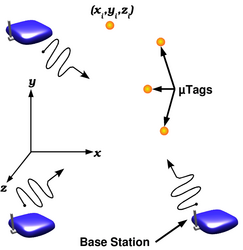µTags : Passive microwave
localization
Jason LaPenta and Joseph Paradiso
Research Sponsored by:
MIT Media Laboratory
Responsive Environments Group
 µTags are low-cost passive
microwave RF-transponders. Primarily used for
tracking large numbers of tagged objects in 3-d,
at short-range (3-100m), and in real-time.
Unhindered localization of objects is desirable
for many applications, including human computer
interaction, product and asset tracking, and security. The proposed system will allow for selection,
identification, tracking, and encoding of data
from connected sensors to be returned to a host by
these passive tags. The concept is illustrated to
the left.
µTags are low-cost passive
microwave RF-transponders. Primarily used for
tracking large numbers of tagged objects in 3-d,
at short-range (3-100m), and in real-time.
Unhindered localization of objects is desirable
for many applications, including human computer
interaction, product and asset tracking, and security. The proposed system will allow for selection,
identification, tracking, and encoding of data
from connected sensors to be returned to a host by
these passive tags. The concept is illustrated to
the left.
µTags utilize emerging technology developed
for RFID and RADAR. A piezoelectric substrate of
Lithium Niobate is patterned to create a Surface
Acoustical Wave (SAW) device. SAW devices were
pioneered in the 1970's, and are now used as
passive filters, correlators, and oscillators in many
telecommunication and RADAR applications. For
this application, the SAW device is designed in a
particular fashion to realize a passive
transponder with encoding capabilities. A dynamic
array of three or more base stations ping a
network of µTags and cooperatively determine
their location based on time-of-flight, angle of
arrival, and phase-shift
measurements. Triangulation calculations are
performed on the resulting range and/or angle measurements from three or more base
stations to localize a tag.
 The SAW
transponders in this application are only powered
by the incident RF energy. A notational diagram of
the patterning used for a simplified SAW
transponder is shown in figure to the right. The
inter-digital transducer (IDT) is a linear array
of metal fingers that change incident electrical
energy from an antenna into a surface acoustic
wave on the piezo-electric substrate. This wave
travels along at a slow velocity (in comparison to
RF) until it reflects off of metallic strips. The
reflected signals return to the IDT and are
retransmitted via the antenna to the
base-station. The gap between the IDT and the
first reflector builds in a delay between the
incident RF burst to the first reflector, which
allows multi-path clutter to diminish before a
rebroadcast, ensuring the base station receives a
clear signal from the SAW transponder.
The SAW
transponders in this application are only powered
by the incident RF energy. A notational diagram of
the patterning used for a simplified SAW
transponder is shown in figure to the right. The
inter-digital transducer (IDT) is a linear array
of metal fingers that change incident electrical
energy from an antenna into a surface acoustic
wave on the piezo-electric substrate. This wave
travels along at a slow velocity (in comparison to
RF) until it reflects off of metallic strips. The
reflected signals return to the IDT and are
retransmitted via the antenna to the
base-station. The gap between the IDT and the
first reflector builds in a delay between the
incident RF burst to the first reflector, which
allows multi-path clutter to diminish before a
rebroadcast, ensuring the base station receives a
clear signal from the SAW transponder.
 A SAW
transponder reflects a short pulse of received RF
energy back to the base-station as a phase-encoded
pattern of data. Our SAW devices are designed to exploit spread spectrum RF interrogation and response signals. An arrangement of correlators
and impedance modulated reflectors on the surface
of the SAW transponder return properly encoded
data patterns back to the antenna for
retransmission to the base station. Several
published techniques for selection,
identification, and encoding of data with the tags
will be applied. A standard one-step lift-off
micro-fabrication process is used to make these
passive SAW transponders. A microscope images of
several initial test devices is shown at the left.
A SAW
transponder reflects a short pulse of received RF
energy back to the base-station as a phase-encoded
pattern of data. Our SAW devices are designed to exploit spread spectrum RF interrogation and response signals. An arrangement of correlators
and impedance modulated reflectors on the surface
of the SAW transponder return properly encoded
data patterns back to the antenna for
retransmission to the base station. Several
published techniques for selection,
identification, and encoding of data with the tags
will be applied. A standard one-step lift-off
micro-fabrication process is used to make these
passive SAW transponders. A microscope images of
several initial test devices is shown at the left.
For more information, see the following documents:
Jason LaPenta -- Real-time 3-d Localization using Radar and Passive Surface Acoustic Wave Transponders (pdf) MS Thesis, MIT Media Lab, August 2007.
© copyright Jason LaPenta and MIT Media
Laboratory (all rights reserved)
Jason LaPenta
Last modified: Tue May 23 12:49 EST 2008

Return to the Responsive Environments Group Projects Page
 µTags are low-cost passive
microwave RF-transponders. Primarily used for
tracking large numbers of tagged objects in 3-d,
at short-range (3-100m), and in real-time.
Unhindered localization of objects is desirable
for many applications, including human computer
interaction, product and asset tracking, and security. The proposed system will allow for selection,
identification, tracking, and encoding of data
from connected sensors to be returned to a host by
these passive tags. The concept is illustrated to
the left.
µTags are low-cost passive
microwave RF-transponders. Primarily used for
tracking large numbers of tagged objects in 3-d,
at short-range (3-100m), and in real-time.
Unhindered localization of objects is desirable
for many applications, including human computer
interaction, product and asset tracking, and security. The proposed system will allow for selection,
identification, tracking, and encoding of data
from connected sensors to be returned to a host by
these passive tags. The concept is illustrated to
the left. The SAW
transponders in this application are only powered
by the incident RF energy. A notational diagram of
the patterning used for a simplified SAW
transponder is shown in figure to the right. The
inter-digital transducer (IDT) is a linear array
of metal fingers that change incident electrical
energy from an antenna into a surface acoustic
wave on the piezo-electric substrate. This wave
travels along at a slow velocity (in comparison to
RF) until it reflects off of metallic strips. The
reflected signals return to the IDT and are
retransmitted via the antenna to the
base-station. The gap between the IDT and the
first reflector builds in a delay between the
incident RF burst to the first reflector, which
allows multi-path clutter to diminish before a
rebroadcast, ensuring the base station receives a
clear signal from the SAW transponder.
The SAW
transponders in this application are only powered
by the incident RF energy. A notational diagram of
the patterning used for a simplified SAW
transponder is shown in figure to the right. The
inter-digital transducer (IDT) is a linear array
of metal fingers that change incident electrical
energy from an antenna into a surface acoustic
wave on the piezo-electric substrate. This wave
travels along at a slow velocity (in comparison to
RF) until it reflects off of metallic strips. The
reflected signals return to the IDT and are
retransmitted via the antenna to the
base-station. The gap between the IDT and the
first reflector builds in a delay between the
incident RF burst to the first reflector, which
allows multi-path clutter to diminish before a
rebroadcast, ensuring the base station receives a
clear signal from the SAW transponder.
 A SAW
transponder reflects a short pulse of received RF
energy back to the base-station as a phase-encoded
pattern of data. Our SAW devices are designed to exploit spread spectrum RF interrogation and response signals. An arrangement of correlators
and impedance modulated reflectors on the surface
of the SAW transponder return properly encoded
data patterns back to the antenna for
retransmission to the base station. Several
published techniques for selection,
identification, and encoding of data with the tags
will be applied. A standard one-step lift-off
micro-fabrication process is used to make these
passive SAW transponders. A microscope images of
several initial test devices is shown at the left.
A SAW
transponder reflects a short pulse of received RF
energy back to the base-station as a phase-encoded
pattern of data. Our SAW devices are designed to exploit spread spectrum RF interrogation and response signals. An arrangement of correlators
and impedance modulated reflectors on the surface
of the SAW transponder return properly encoded
data patterns back to the antenna for
retransmission to the base station. Several
published techniques for selection,
identification, and encoding of data with the tags
will be applied. A standard one-step lift-off
micro-fabrication process is used to make these
passive SAW transponders. A microscope images of
several initial test devices is shown at the left.
